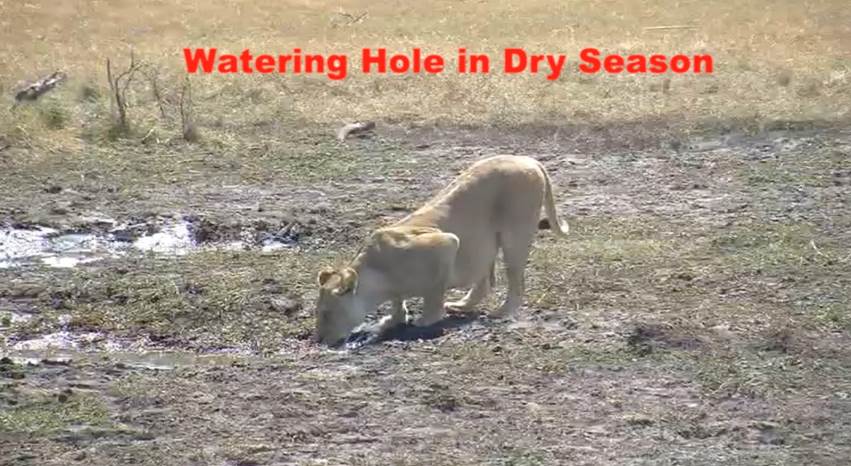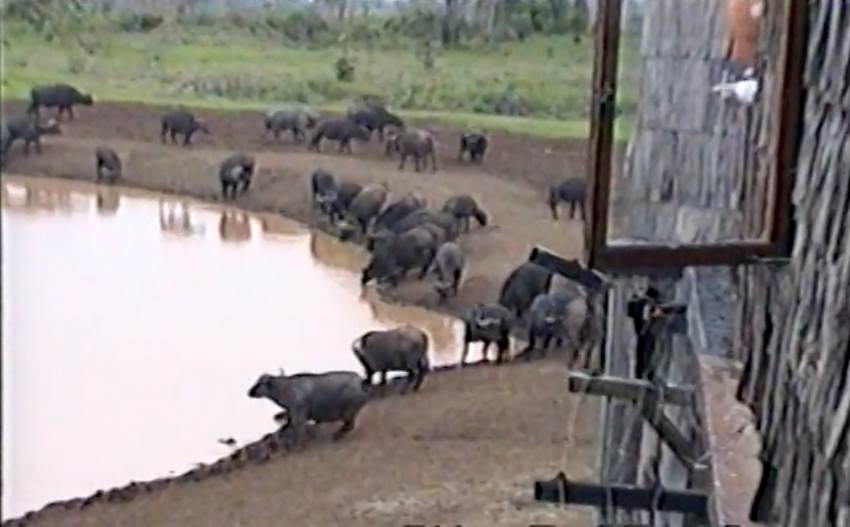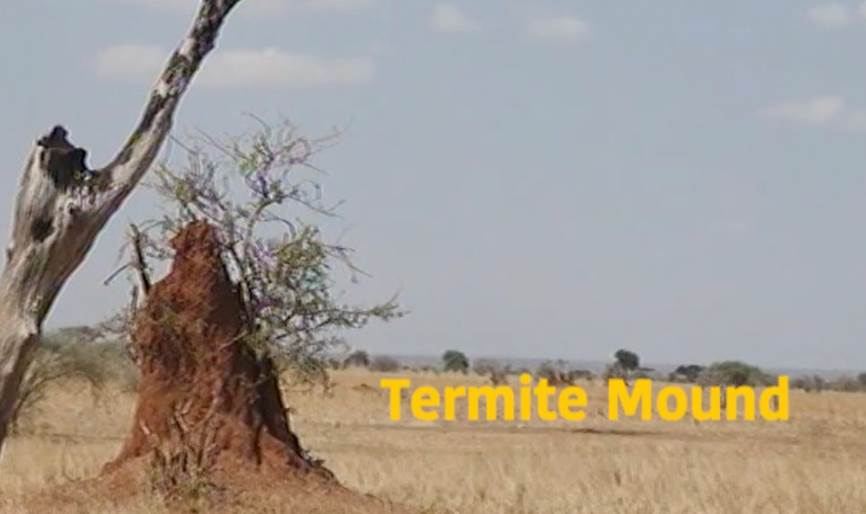

It so happened that our family got the same suite in which the royal couple was staying. There is a nameplate outside which reads ‘# 18 Princess Elizabeth’s Suite’
A Memorable Visit to Africa
By Dr Khalid Siddiqui
Ohio

We went to East Africa (Kenya and Tanzania) in 1994 on a wildlife safari. I wouldn’t be writing about the birds and other animals I encountered there, as our community in general doesn’t have much interest in this topic.
On the second day of our arrival, we drove to Aberdare National Park in the town of Nyeri located about 100 km from Nairobi. In this town Robert Baden-Powell, the founder of the world-wide Scout Movement is buried. His wife’s ashes are also buried next to him. In the park we stayed at a hotel called Outspan. This is the gathering point from where tourists are taken to an interesting place called Treetops, about 15 km away.

Robert Baden-Powell, the founder of the world-wide Scout Movement is buried in the town of Nyeri located about 100 km from Nairobi
Treetops is a wooden lodge next to a watering hole. The lodge rests on wooden supports. It was opened in 1932. The tourists are lodged overnight in the suites on the second and third floors. The rooms have windows that open to the watering hole where all kinds of animals come for water, and to lick salt from the soil around it. Sometimes, at night the elephants also visit the area to lick salt. There is a terrace on the roof which gives a panoramic view of the watering hole and the jungle beyond it. After dinner all lights inside the lodge are turned off. However, some soft lights are left on outside for the tourists to see the animals that visit the watering hole at night. If an interesting/unusual animal shows up, then a bell is rung outside the doors to alert the tourists who could then watch the animals from their windows.
Treetops became famous around the world following an incident in 1952. Princess Elizabeth and her husband, Prince Philip, were staying at the Treetops on February 5, 1952 when they got the news of Elizabeth’s father, King George VI’s, death. They left immediately in the morning of February 6 – she as the Queen Elizabeth II. There is a plaque there describing this incident.
Charlie Chaplin and Paul McCartney had also visited this place.
It so happened that our family got the same suite in which the royal couple was staying. There is a nameplate outside which reads ‘# 18 Princess Elizabeth’s Suite’.
Soon after midnight, the bell rang. We looked outside and saw two elephants licking the salt. The lighting was poor, but enough to take video footage. The lighting is kept dim intentionally so as not to disturb the nocturnal creatures.
The water level in this watering hole is maintained artificially. This brings the animals there year-round, which is good for the business. In the natural watering holes, the water level goes down drastically during the dry season. It also gets shallower because of the buildup of the silt. At the Treetops the watering hole is dredged periodically to remove the sediment. Also, the salt is sprinkled over the clay around the watering hole, again to attract animals, especially elephants.
I now describe the lifecycle of a natural watering hole and how precariously the natural world is balanced, and how easily it could all be destroyed even if a single link in this chain is severed.
Anyone who has been to Africa on safari trips must have noticed watering holes, scattered throughout the grassland, where animals gather to drink water. Some animals like hippos and Nile crocodiles, however, stay in the rivers.
How these watering holes are created is an amazing story. It starts with the termites. The termites build their nests underground. In doing so, the worker-class among the termites excavates a large amount of nutrition-rich soil and builds a mound of clay, of varying sizes, above the ground. The mound regulates the temperature, and facilitates the ventilation of the nest. The worker-termites constantly repair any damage to the mound caused by the animals or the elements. The termites, usually, abandon their mound and nest in about five years, and start a new colony somewhere else.
The animals, like elephants, use these abandoned mounds as scratching posts. They also eat the nutrition-rich clay. This rubbing and eating as well as the rain, wind and elements slowly disintegrate the mound. After sometime, only a rounded sunbaked patch of clay, where once the mound stood, is left behind dotting the landscape. Elephants use their feet and strong toenails to chip off pieces of this residual nutrition-rich clay, and eat it. In doing so, a ditch is created which becomes a muddy pool after a rain. The elephants then wallow in the mud to get relief from sunburn and stinging flies. They leave the pool with a large coating of mud on their skin. This further enlarges the pool.


How these watering holes are created is an amazing story. It starts with the termites
As the hole gets deeper, the water dissolves more nutrients and minerals from the deeper layers of clay. So, the attraction of dissolved minerals continues to lure the elephants to the hole. The constant traffic of the elephants makes several deep trails on the ground. The enlarging pool gets water directly from rain, as well as the runoff water from the neighboring grassland along those trails which now act as drains. As the elephants visit many watering holes in a day, many fish and frog eggs take a ride on their feet to this new enlarging hole. Here these eggs hatch into fish and frogs. This attracts the birds, like kingfishers and storks. The elephant’s digestive system is very poor. Their dung, therefore, contains lots of undigested seeds. This as well as the seeds in the birds’ droppings cause many plants and shrubs to germinate along the banks of the pool which is, by then, already a small watering hole. The vegetation stabilizes the soil, and stops the erosion along the banks and silting up of the watering hole. The watering holes are the main source of water for the antelopes. It, therefore, is also the prime hunting ground for lions, leopards and cheetahs.
As the dry season approaches, the water level in the hole drops. The grass in the grassland starts drying out. So, all the vegetation around the hole is also devoured by the antelopes. This destabilizes the soil and, therefore, erosion sets in. Elephants come to drink whatever water is left, and in the process cause more mud sliding off an already vegetation-depleted unstable soil. This further shrinks the watering hole, which by then, is reduced to a muddy pool. And if a flock of red-billed quelea (the most abundant wild bird in the world) happens to descend on it then the whole watering hole could be emptied out in a single day!
Before the fish and frogs die, they lay eggs and bury them in the mud. The lungfish buries itself in the mud. The zebras and wildebeest, and other smaller antelopes, migrate to the greener pastures. The elephants persist for a little longer. The matriarch and the other senior members of the herd can SMELL water under the dry watering hole. They dig deep with their feet and tusks, and siphon off with their trunks whatever little water remains deep down there. They also then leave the area.
Six months later when the first rains come, the watering hole is rejuvenated. The fish and frog eggs hatch; and the lungfish comes out from its underground tomb alive. (The lungfish can remain in the state of estivation without food, water and air for up to five years!) The whole process is repeated every six months. The survival of the watering hole, therefore, depends upon how much mud the elephants remove (coated on their skin) and how much the hole is silted up by erosion of the soil during the course of the six months. Over the next several years, the silting process accelerates as the elephants move on to newer watering holes. Within a century, the watering hole is completely silted up. Vegetation grows over it, and it becomes a part of the vast grassland.

Roasted termites are a delicacy. But their number is so huge that there is no shortage of termite mounds in Africa. However, the fate of the watering hole’s other parent, the elephant, is not so assured
A watering hole is the lifeline for the antelopes as there are not many rivers flowing through the grassland. Moreover, the few rivers that are there, are infested with Nile crocodiles who patiently wait for a stray animal, and the animals know that. So, they avoid the river as much as possible.
In short, if there are no termites and elephants, then there will not be a watering hole. The termites are eaten by birds, frogs, insects, ants, cockroaches, snakes, lizards, spiders, mice, anteaters, monkeys and native Africans. Roasted termites are a delicacy. But their number is so huge that there is no shortage of termite mounds in Africa. However, the fate of the watering hole’s other parent, the elephant, is not so assured.
I have been to Botswana twice. The photographs of the watering holes are from Botswana.

